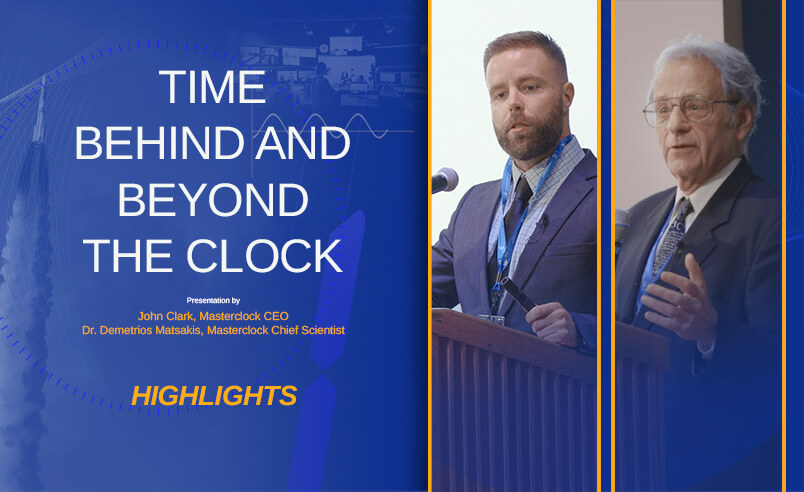02/23 By Dr. Matsakis
Masers, Lasers, And Their Creators
The French say that success has 100 fathers, but failure is an orphan. The French say a lot of things. In my younger days I took that as a cynical, though probably correct, observation of human behavior. But after I became a director, I realized that any success took many people working together. Maybe not 100, but people do better when they play off each other, and part of the job of a manager is to see that they do so constructively.
Enter my graduate advisor, Charles Townes, way back on April 26, 1951. As the sun rose, he sat down on a park bench at Franklin Square in Washington DC [1]. A tenured professor at Columbia University, Townes had come for a meeting of the Navy’s millimeter committee and was feeling embarrassed about the lack of progress they had been making. As he enjoyed the dew-covered red and white azaleas in full bloom, the idea of the laser/maser principle came to him.
The laser/maser concept is simple: you just prepare atoms, or molecules, so that they are primed to radiate in a certain way. This is called population inversion. Then expose them to incoming radiation at exactly the frequency they have been primed for. That will induce the molecules to emit at once, and they will radiate a coherent beam [2]. If you add a resonator, which can even be two mirrors to bounce the radiation back and forth, even more atoms will be induced to emit. The result will be a strong beam that can be used for all kinds of things – nowadays from surgery to anti-missile defense systems. For a few more details on how they work, see my last footnote [17].
 A statue commemorating Townes's "AHA moment". It is located in Greenville SC, his hometown.[3]
A statue commemorating Townes's "AHA moment". It is located in Greenville SC, his hometown.[3]
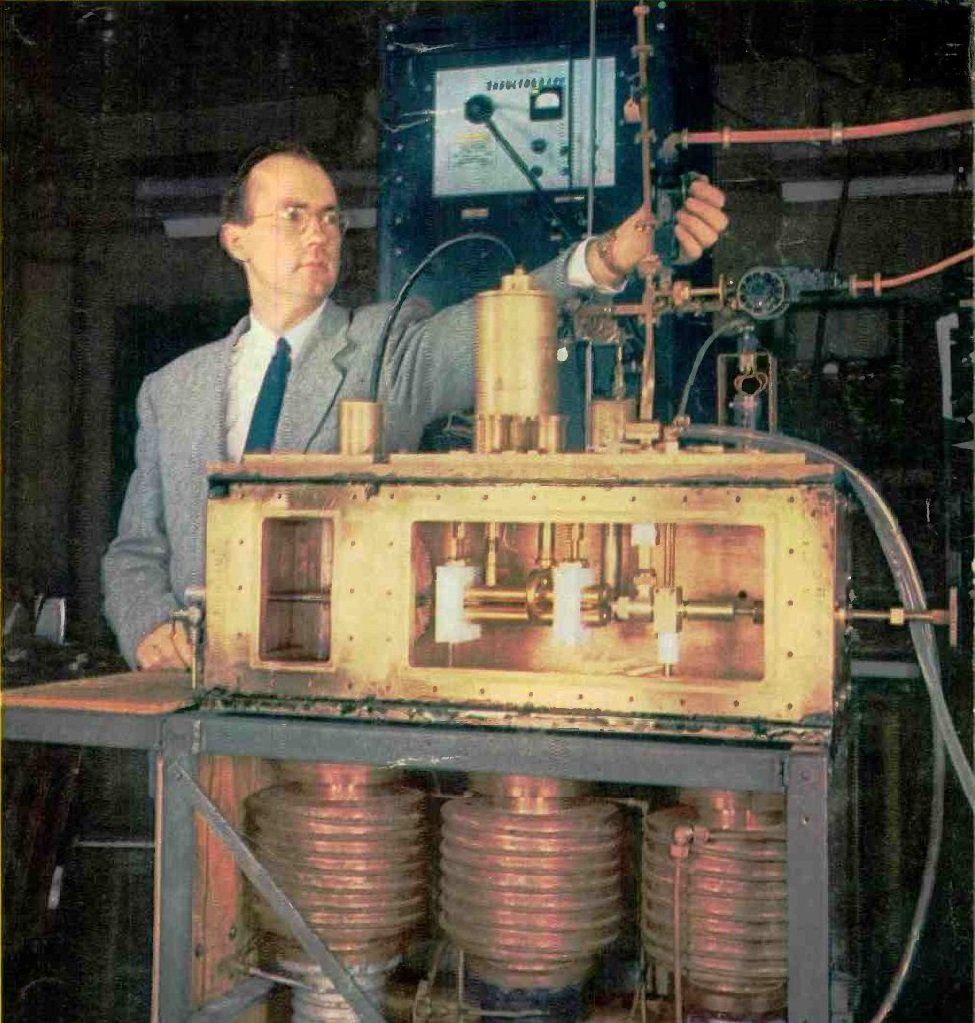 Townes with the first maser, 1954
Townes with the first maser, 1954
Townes didn’t mind telling people about his big idea, even though many of them insisted he was wrong. The criticism was so bad that at one point the Chairman of the Physics department and another professor, both Nobel Laureates, came to his office and asked him to stop this research because it would make the university look bad and threaten their funding, they claimed [4]. One of Townes favorite stories was of a third colleague who told him the maser won’t work because the population inversion (more molecules in the energized state than the non-energized stated) violated fundamental physics – thermodynamics to be specific. Then when Townes was able to demonstrate clear-cut population inversion, he was told that this measurement was correct, but for the wrong reason. And then when he got the maser working in all its glory, this colleague told him “it was obvious”. Of course, in 1964 the Nobel Committee showed they didn’t think it was so obvious.
Townes named his invention the maser, because he used microwaves, as in a microwave oven. Maser stands for Microwave Amplification by Stimulated Emission of Radiation. As in many discoveries, several people had found pieces of it before Townes – but they hadn’t put all the pieces together. Nor did Townes do all the lab work. He had students in the lab, and his research group hosted a constant stream of visitors who freely shared ideas and often collaborated with him on conference papers and formal publications. In fact, for this reason Townes shared much of his prize money with his assistants and colleagues. That was the kind of guy he was [5].
One of those visitors was Gordon Gould, a PhD. student who was working on thallium beams. Gould’s professor had asked Townes to befriend him, because it seemed Gould would never get his thesis done. So Townes would talk with Gould from time to time, and in 1957 Townes asked Gould to come to his office so he could ask him some detailed questions about the thalium lamps from Edmund Scientific that he was using. Townes told Gould it was because he wanted to build an optical maser that works with light instead of microwaves (hence the term laser [6]). Gould indicated that he was thinking about this as well. It turned out that, after this meeting, Gould wrote down the general idea of a laser in his notebook, and had it notarized. It came up in a court case against Townes later, but Gould lost. And he should have lost, because Townes had formulated the concept of an optical maser from the very beginning, and made no secret of it. But he wasn’t ready to address the technical details right away, and in fact the first person to actually build a working laser was Theodore Maiman in 1960, who patented the pink ruby laser [7].
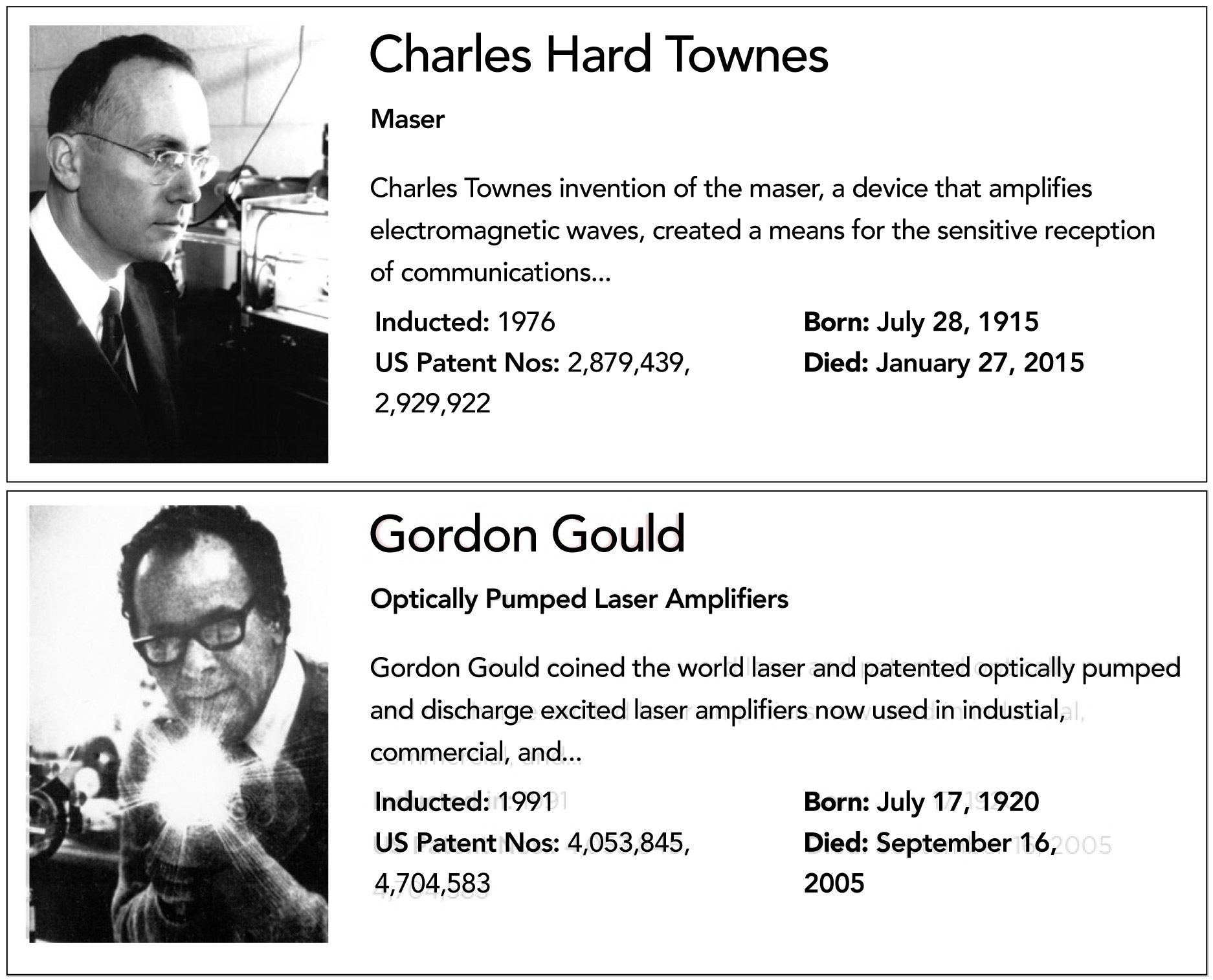
TOP] Charles Townes exhibit at the Inventor's Hall of Fame. The second patent, 292992, dated 1958 is available from pto.gov. It clearly refers in many places to using not just microwaves, but also infrared, ultraviolet, and light as the beamed output. [BOTTOM] Gordon Gould exhibit at the Inventor's Hall of Fame. The first patent is for using a laser inside a catheter. The second one is basically the same as Townes’s, except it retains only the references to light and makes no mention of mirrors.
Yet 20 years later, in 1977, in a lawsuit to which Townes was an expert witness but not a defendant, Gould won some patents for some aspects of the laser, which made him a millionaire [8]. But the victories were strangely won. Gould won a patent for creating a laser without mirrors – Townes didn’t include the possibility of not using mirrors in his 1958 laser patent because it seemed only natural that a patent for a device with mirrors would apply to one without. But more importantly, Townes also knew that without mirrors the laser was a natural process known to exist in the Martian atmosphere - and natural processes can’t be patented. But the opposing lawyer made a joke about Martians, which apparently succeeded in trivializing the science.
The jury also had to decide if the internal reports Townes had written constituted a valid claim to have been first. Apparently, their decision was “no.” Well, patent laws have since been revised – they are now based upon being the first to file rather than the first to invent. And if you have published an invention before filing, it is already in the public domain and you can’t get a patent. Also, juries are now used only to decide factual issues, not legal ones.
Anyhow, that’s the history as I see it. I believe Townes’s side of the story. Having studied under him at Berkeley for nearly six years, from 1973 to 1978; observed the heavens with him during late hours at many astronomical observatories; and then continued to publish papers with him for several years thereafter– I know how Charles Townes worked. He surrounded himself with brilliant post-docs, assistant professors, and visiting scientists, more than one of them going on to win the Nobel Prize [9, 10]. And he was equally willing to take chances with students. He’d point us in a direction, periodically come by to ensure we were on track, and always insisted on having his name last in any publication, if at all [11].
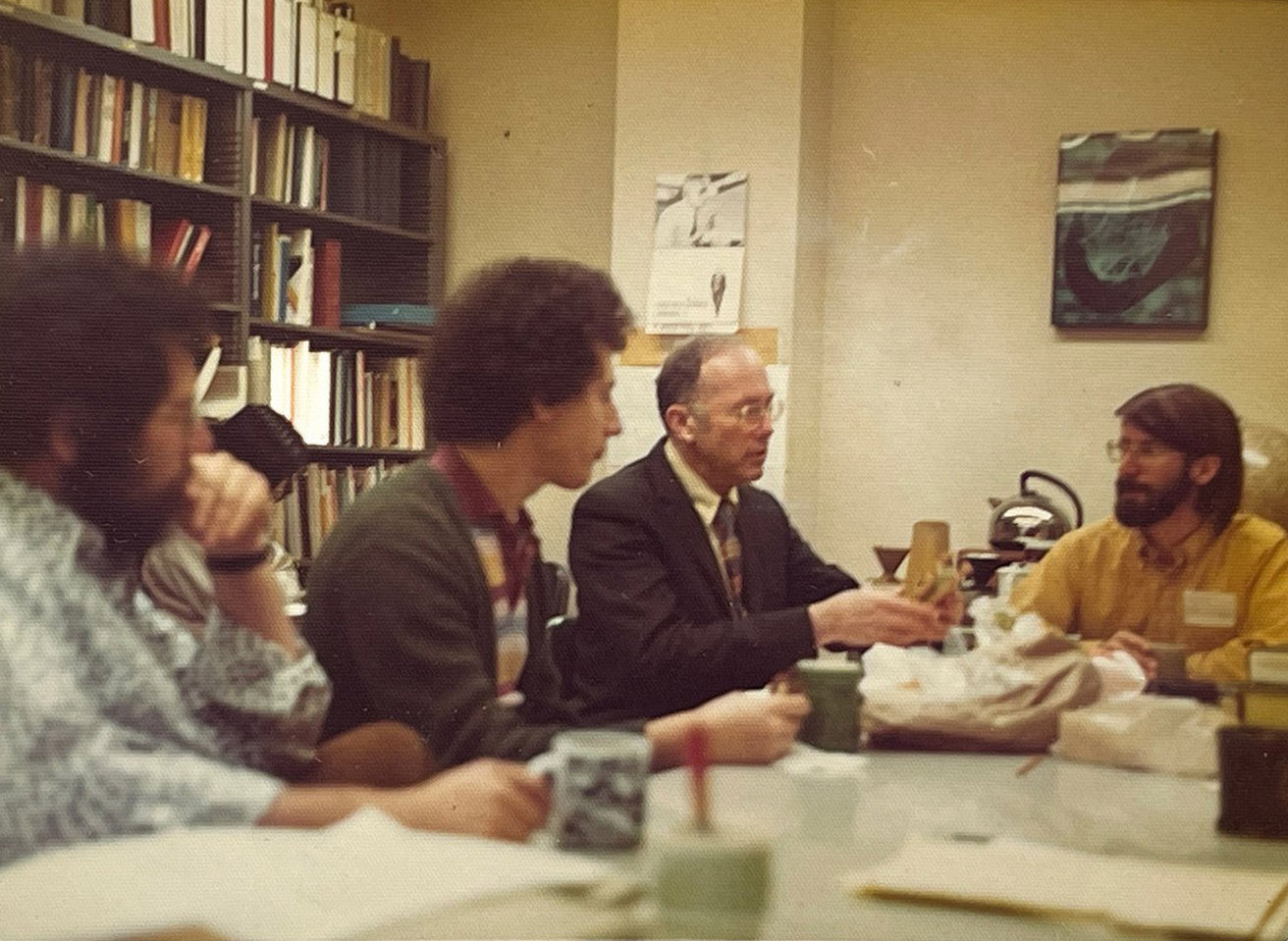 Townes lunching with some of his graduate students at Berkeley, in the mid-70's. To the left is Larry Greenberg, now a retired Vice President of Aerospace Corporation, followed by Tom Geballe, now Professor Emeritus at the Gemini Observatory. To the right is John Lacy, now a professor at U. Texas, Austin. Mike Chui is by the bookcase.
Townes lunching with some of his graduate students at Berkeley, in the mid-70's. To the left is Larry Greenberg, now a retired Vice President of Aerospace Corporation, followed by Tom Geballe, now Professor Emeritus at the Gemini Observatory. To the right is John Lacy, now a professor at U. Texas, Austin. Mike Chui is by the bookcase.
In his library, which served as a lunch room, there were often long discussions with these people as well as us graduate students, filling the blackboard with equations. With grad students and post docs constantly heading back and forth from observatories, or building new devices in the lab, there was always a hot topic to be shared with the group. As one student put it, “Townes expected that everybody would want to know everything about everything.” While we may not have achieved the status of Renaissance scientists, there was a sense that we could accomplish anything we wanted to if, as he often put it, “the physics was sound”[12].
Along with being the most brilliant person I have ever met, he was probably the most ethical [13], and soft-spoken too. He was ahead of his time in recognizing the intrinsic humanity in each of us [14].
To be fair, while Gould may not have been all he claimed to be, he was a player [15]. His induction into the Inventor’s Hall of Fame, in 1991, had some justification. And the full truth, and nothing but the truth, is that it took more than 100 fathers, plus a few mothers, to make masers and lasers what they are today. Just like it took more than one engineer to make a GMR5000.
Footnotes
[1] See “How the Laser Happened”, by Charles Townes, Oxford University Press, 1999. Also “The Laser in America, 1950-1970”, by Joan Lisa Bromberg, MIT Press, 1991.
[2] It was Einstein who came up with the formula for how radiation can stimulate still more radiation from energized atoms, in 1917.
[3] In 2015 I began trying to get the National Park Service to put a plaque commemorating this on a random bench in Franklin Park, which it owns. Other former students of Townes told me I could not succeed, and maybe they were right. But I had some success. The NPS was happy to add a reference to the web pages on Franklin Square once I could demonstrate the veracity of the story. It took a few years because they were doing it as part of a large web page remake. You used to be able to find it here: https://www.nps.gov/nr/travel/wash/dc29.htm, but I checked just now and found the link is stale. More importantly, there is big money being set aside to revitalize Franklin Square itself and they promised to add Townes’s AHA moment to a timeline display. We shall see. Once the park is complete, I may try to get a plaque added to one of the benches. Right now, the architects are not returning my emails and telephone calls.
[4] The two physicists were Isidor Isaac Rabi and Polykarp Kusch, both of whom readily apologized to Townes afterwards. The Rabi Prize is among the most prestigious awarded by the American Physics Society.
[5] Townes did it again when he won the prestigious Templeton Prize for finding consistency between science and religion. He gave half his $1.5 million prize money to his alma matter in Greenville, and distributed the other half to various faith-related institutions. For more on his view on religion, you can watch Taran Brar’s documentary,“The Marriage of a Scientist”, which will shortly be available through sciencemarriage.com.
[6] Townes originally thought “laser” was an unnecessary term, and preferred “optical maser”. This is because, to a physicist, light is not fundamentally different from microwaves. The application of the maser principle to light was something he and “everyone” was aware of since the beginning. The technologies are different though. For example instead of a using a cavity, a typical laser uses mirrors so the light will get amplified again and again as it bounces back and forth.
[7] Mainman did his thesis work under Willis Lamb, for whom the Lamb shift is named after. The Lamb shift is one of the proofs that elementary particles can appear in the vacuum, out of nothing, provided they quickly annihilate each other. (Steven Hawking used that fact to predict that all black holes will evaporate eventually.) Yet even this pedigree did not help Mainman publish his laser paper. Before being published in Nature, it was rejected twice in the more scholarly Physical Review Letters! But for what it’s worth I was very impressed a few years later, when as a teenager I saw the laser briefly featured in the Beatle’s movie Help.
[8] Townes did well from his patents too. He would have made more money, except he gave free license to the government, to the universities, and for all educational purposes.
[9] In my time there, twenty years later, I worked directly with a Swede, an Australian, a Chinese citizen, and a Russian [9a]. I shared my office with John Lacy, and I was the first person to know when he and Townes interpreted John’s observations of ionized neon from Cerro Tollolo, Chile, to mean that the hypothesized black holes actually existed in the universe. Reinhard Gentzel, a postdoc and later a professor with Townes, won the 2020 Nobel Prize for identifying that black hole with the radio source SagA*. Years later I learned that Townes had given my very office to John Clauser, as a lab, to demonstrate quantum entanglement, which Einstein termed “spooky action at a distance”, and which won Clauser the 2022 Nobel Prize for physics. And my 3-person office was just one of many in Townes’s floor.
[9a] After the Russian left for home, the FBI left me a telephone message at my group house. This was in Berkeley, in the Nixon/Vietnam days, and it made a small sensation. Some of my housemates thought the FBI was after them, because of brief encounters with Patty Hearst personalities and other radicals, but it turned out all the FBI wanted to know was if my Russian colleague was a spy. I told them he was a Communist who made no secret of the fact that his native Siberia was the best place in the world, but otherwise did nothing suspicious. (I now know somebody who, totally innocently, sold an almost new car to a nice-looking youngster for cash. Only when my friend got a call from the FBI did she learn that the purchaser was a gun-toting member of the Symbionese Liberation Army.)
[10] He once even allowed the since-exposed fraudulent magician Uri Geller to try to prove his telekinesis skills to us [10a]. Each one of us was assigned a different part of his body to watch. But there was no need, as Geller failed completely at bending spoons and everything else.
[10a] The plot gets thicker. I believe it was Russel Targ , from Stanford Research Institute, who asked Townes to permit the demonstration. (I only remember that he had something to do with Stanford). The Wikipedia tells me Targ had gotten into parapsychology in this time frame and guess what? He was also identified there as a collaborator with Gould! It says something about Townes that he would show Targ this respect while Gould was actively contesting Townes’s claim to the laser [10b].
[10b] I don’t believe in the various forms in psychokinesis, clairvoyance, etc., but the night Townes died I woke up because I feared something had happened to him. I did an internet search, found nothing, and went back to bed. It was not until 12 hours later that the internet began reporting that he had died in his sleep. Given the time zone difference, the discovery of his death was about three hours after I woke up. Many people have reported such incidents. But in my case, I had a false alarm in another situation a year later. Still, I am open to considering the possibility that quantum entanglement is related to, or even responsible for, the human mind.
[11] He took his name completely off one of my papers, because he felt he hadn’t done enough to justify it. That’s the only time I know of when Townes was wrong.
[12] Even my golden, curly-haired girlfriend noticed this when she came to Hat Creek Observatory in California and quietly watched while Townes, Al Cheung[12a], and I were trying to figure out how to interface our specially-designed maser with their woefully undocumented electronics and finicky 70’s-vintage computer. Her comment was that “none of us knew how anything there worked, but we were sure we would get it working”. It took a few years and a few 3-week trips, but I finally did finish my thesis.
[12a] Al was a student of Townes who, about eight years earlier used just one of my two 20’ radio telescopes to discover water and ammonia in the interstellar clouds where stars are born. I read about it in high school, though if they mentioned his name I would have forgotten it. What I didn’t know was that he and Townes had first submitted a proposal to use a large antenna run by the National Radio Astronomy Observatory, in Green Bank West Virginia for this purpose. It was rejected because the referee said the harsh environment of outer space would destroy the molecules, but even if it didn’t the 3-degree microwave background left over from the Big Bang would thermalize the molecules and thus render them invisible. And guess what the source of the water emission turned out to be? Masers, of course [12b].
[12b] A few years later I installed a maser at Cal Tech’s observatory in Owens Valley. Using a maser to observe masers, we were able to get some beautiful maps and spectra, showing the maser cloudlets were moving at hundreds of miles per second. Here are some pictures of what Craig Walker, Jose Garcias-Baretto, and I published:

But we, the afterborn, had it easy. We used giant (>100’) antennas and knew where to look. Al had only a small antenna, built the entire back-end electronics himself, and must have wondered if the referee was right about the impossibility of detecting anything. When he detected the water, he excitedly called Townes. Frances Townes answered the phone. They were having a Christmas party, and she dead-toned “It’s raining here too”. I guess she was used to big discoveries.
[13] While he had plenty of grant money and little oversight, he scrupulously ensured that every penny was spent on the project covered by the grant – to the point of apportioning gas usage when driving to work on two different projects. A secretary once told me, in an astonished way, that before he took books home from our group’s library he would clear it with her. I suppose the books were technically property of the University of California.
[14] It might be a Townes family trait. It turns out he received the Nobel Prize at the same ceremony as Dr. Martin Luther King. Townes’s aunt had helped MLK in the 1950’s, and Townes was wondering if he should say something. But he didn’t have to. The famed civil-rights leader walked right up to him, and asked Townes if he was related to the Mrs. Townes he knew.
[15] Also, Netflix subscribers can view History 101’s clip on the laser. Surprisingly, it does not even mention Townes, and special insights attributed to Gould are things that were taught in schools at that time. But in its defense, the main emphasis of the Netflix clip is on all the wonderful things lasers can do in real life, and of course can even do better as depicted in SciFi movies. So let’s just say they did a great job tying modern laser technology to science fiction.
[16] Would it be giving up all pretense of impartiality if I pointed out that our second Vice President, Aaron Burr, was also a player?
[17] The very last footnote, on the physics of masers and lasers.
As shown in the simplified picture of an example atom, Quantum Mechanics says atoms can only be in states A, B, or C. No other states are allowed, and each state has a different energy. Thermodynamics says there will always be more atoms in the lower energy state. Atoms can change their state to higher energy by absorbing radiation (light or microwaves), or to lower energy by radiating.

The next step is to find an atomic species that has a state B which does not readily radiate. We expose the atoms to “pump radiation” which has exactly the right energy to push atoms from state A to C. From C they will give off radiation and drop down to either A and B. Atoms falling into state B just stay there, doing nothing. Those in state A absorb more radiation from the pump, and go back to C. You will quickly have more atoms in state B than state A. That’s population inversion. Then send in radiation with exactly the right energy to stimulate atoms in state B to drop to state A and emit radiation. That’s the laser, which Townes and others called an optical maser.
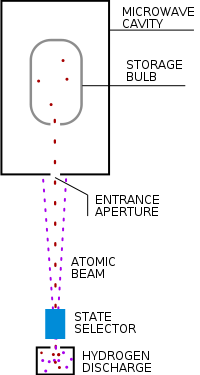 Picture Courtesy of Wikipedia
Picture Courtesy of Wikipedia
Townes was always aware of the potential for masers as clocks. While Rabi from Columbia U, and later Lyons from NBS/NIST, are credited with inventing and developing the cesium atomic clock in 1955, I think the real driver for the hydrogen maser clock was Townes, who modestly encouraged Ramsey, Kleppner, and Goldenberg to build one. They succeeded in 1960.
Today, the most precise commercial clock is the hydrogen maser, which can measure one day (86400 seconds) to roughly 80 picoseconds. The maser in the picture is called an active maser because it creates the output radiation.
In the bottom of the image, hydrogen atoms leave the discharge unit and pass to the state selector. That acts as a kind of pump because only atoms in excited states, ready to radiate, pass through the aperture into the storage bulb, which is a resonant cavity designed to trap only radiation of the specific wavelength of hydrogen. There they are induced to radiate by a standing wave of radiation from atoms that previously entered the bulb. A small amount of signal is allowed to exit the bulb as an electric current on a wire (not shown). The periodicity of that signal is taken as a fixed fraction of a second, much as the period of a pendulum is used to measure the time of day.
About Dr. Demetrios Matsakis
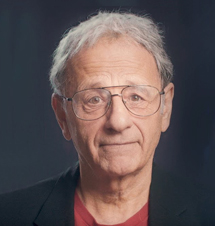 Dr. Demetrios Matsakis attended MIT as an undergraduate and received his PhD in physics from UC Berkeley, where he studied under the inventor of the maser and laser; and built specialized ones in order to observe interstellar dust clouds where stars are born. His first job was at the U.S. Naval Observatory, building water vapor radiometers and doing interferometry to observe quasars and galaxies at the edge of the observable universe. After developing an interest in clocks, Dr. Matsakis would spend the next 25 years working hands on with most aspects of timekeeping – from clock construction, to running the USNO’s Time Service Department, to international policy. He has published over 150 papers and counting, but gets equal enjoyment out of beta-testing his personal ensemble of Masterclock products.
Dr. Demetrios Matsakis attended MIT as an undergraduate and received his PhD in physics from UC Berkeley, where he studied under the inventor of the maser and laser; and built specialized ones in order to observe interstellar dust clouds where stars are born. His first job was at the U.S. Naval Observatory, building water vapor radiometers and doing interferometry to observe quasars and galaxies at the edge of the observable universe. After developing an interest in clocks, Dr. Matsakis would spend the next 25 years working hands on with most aspects of timekeeping – from clock construction, to running the USNO’s Time Service Department, to international policy. He has published over 150 papers and counting, but gets equal enjoyment out of beta-testing his personal ensemble of Masterclock products.

